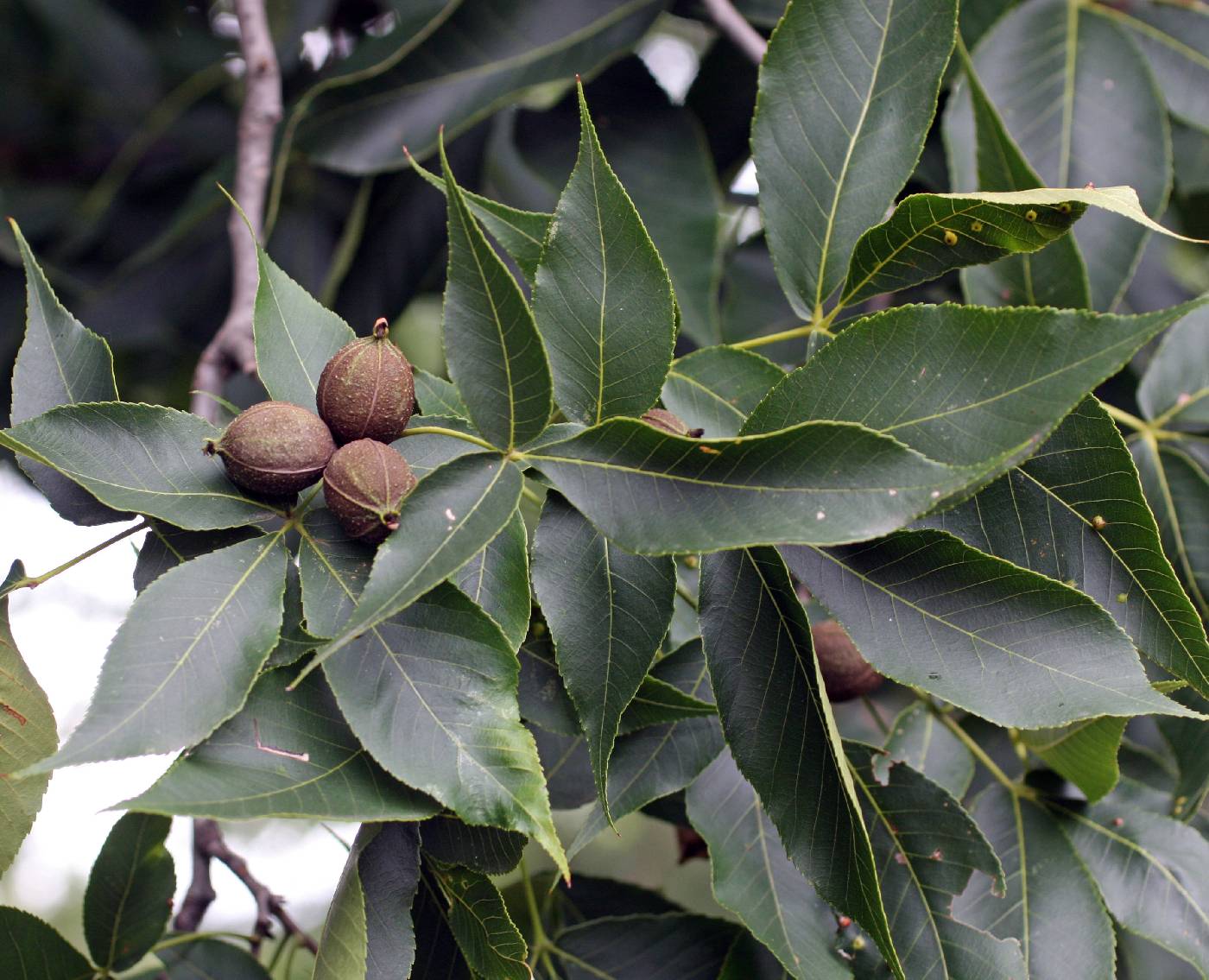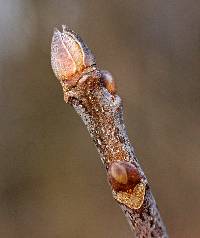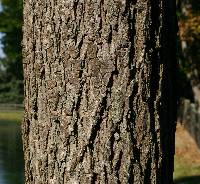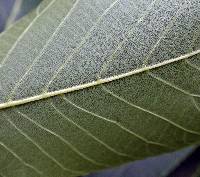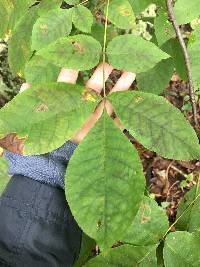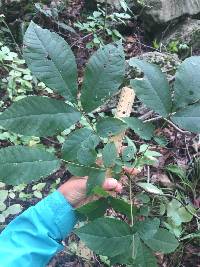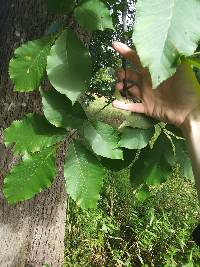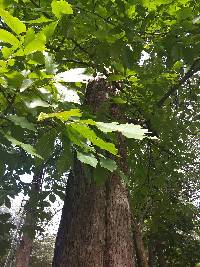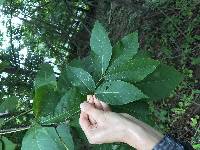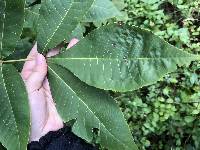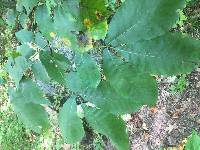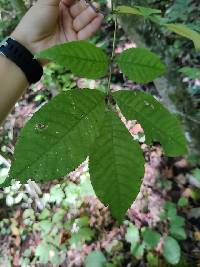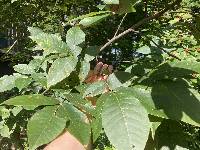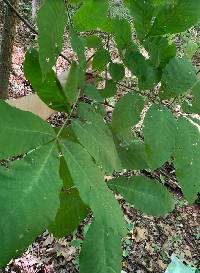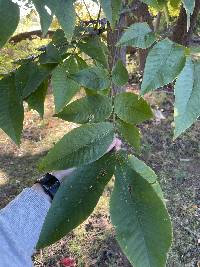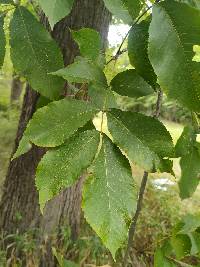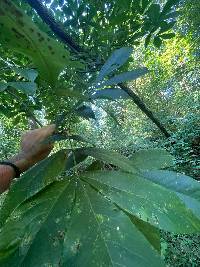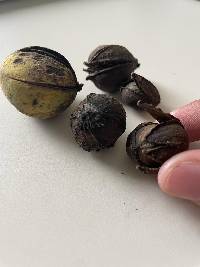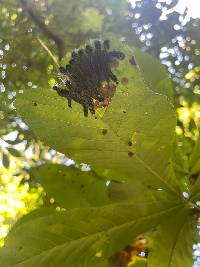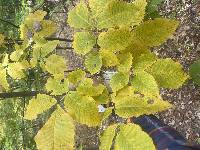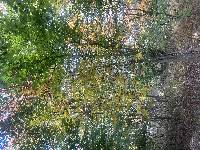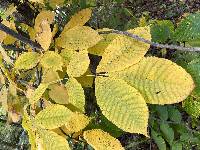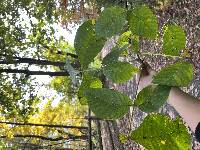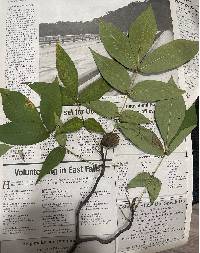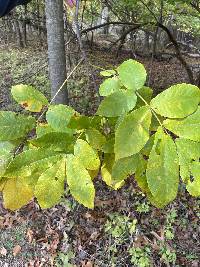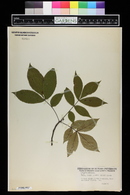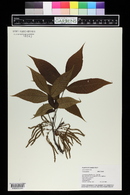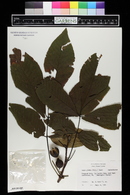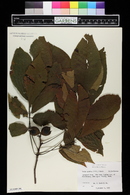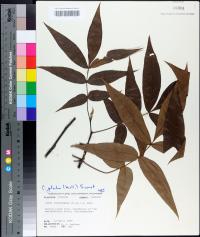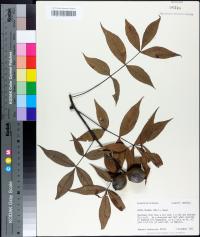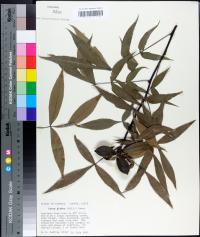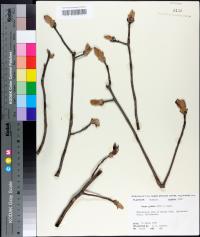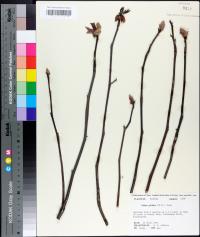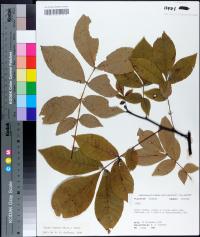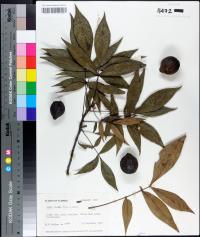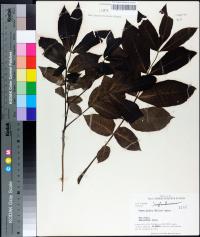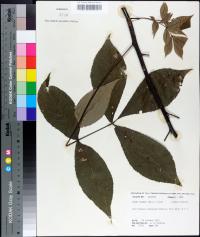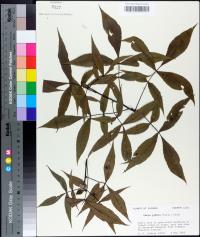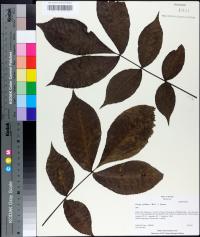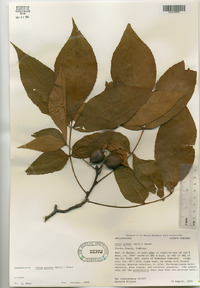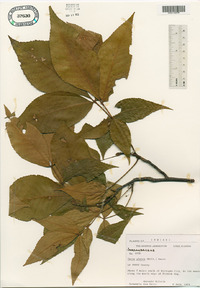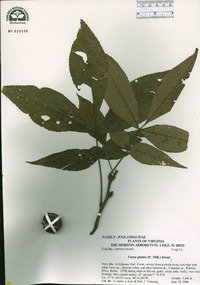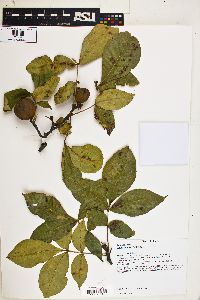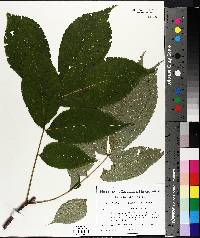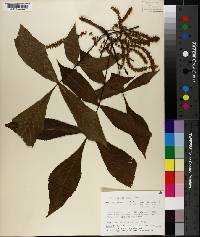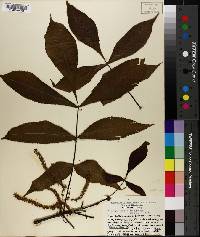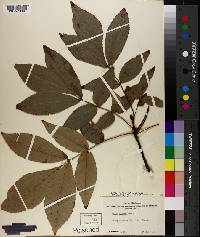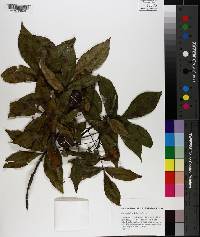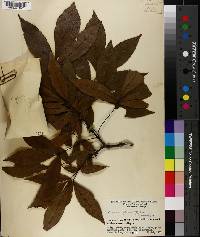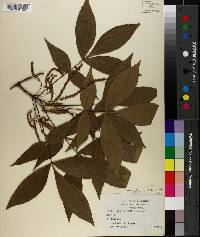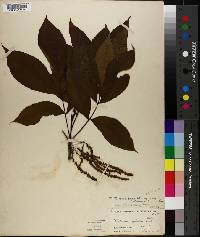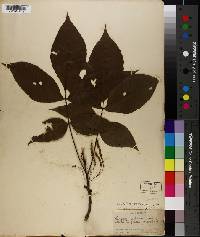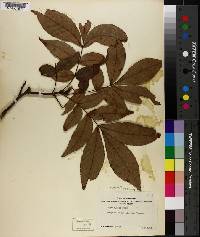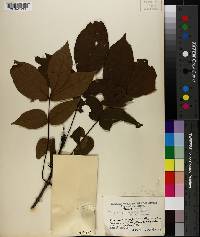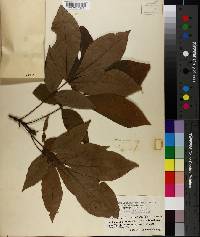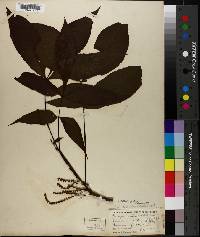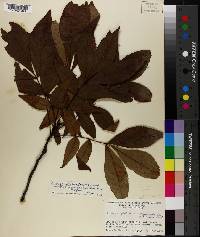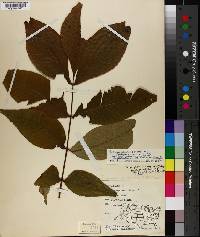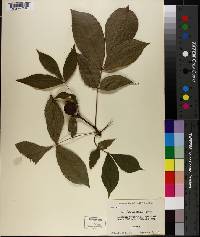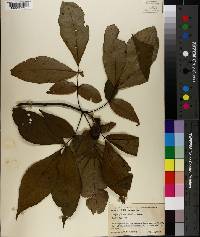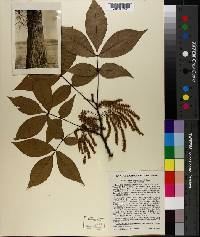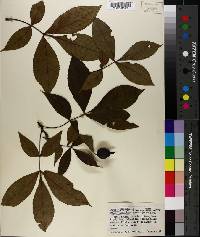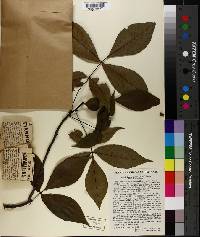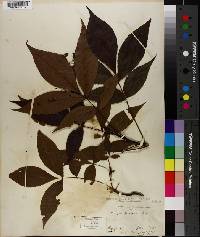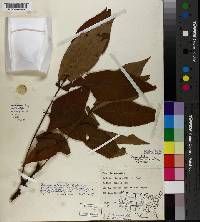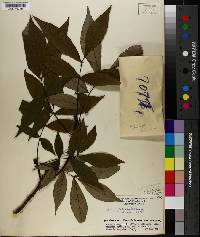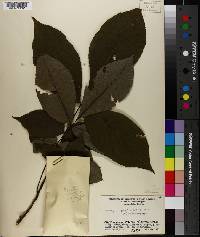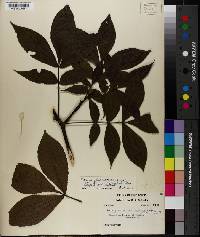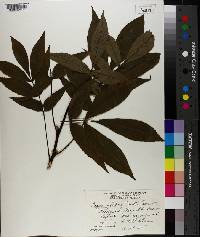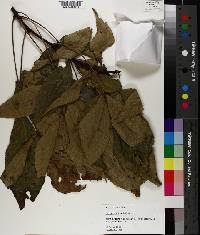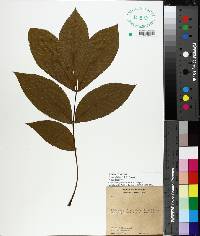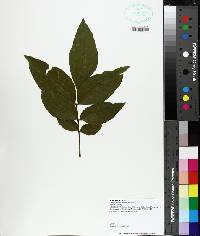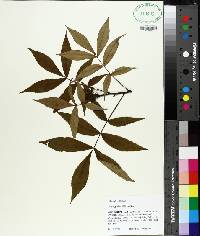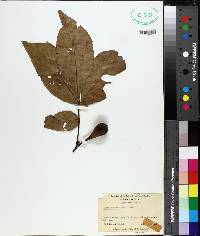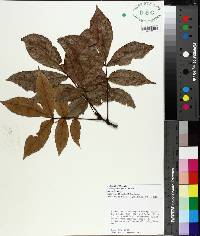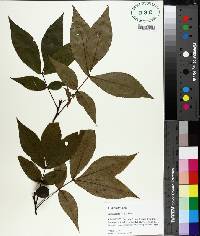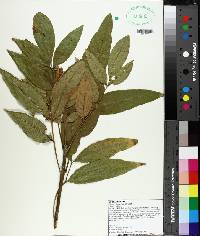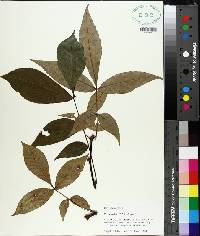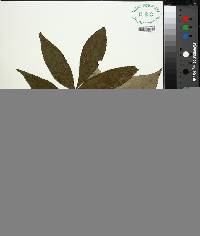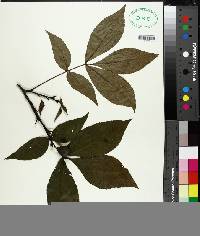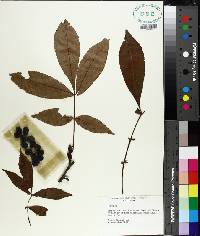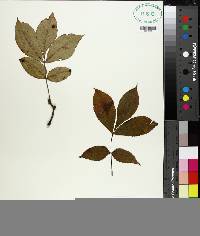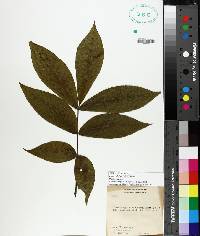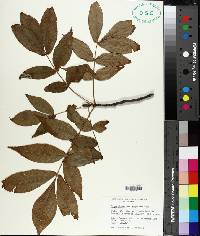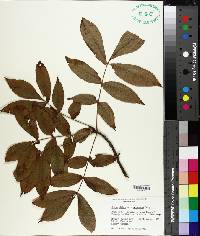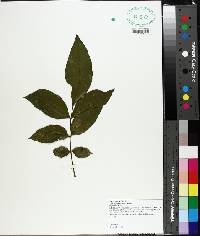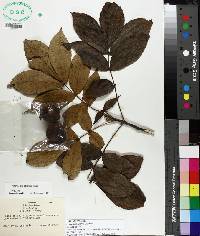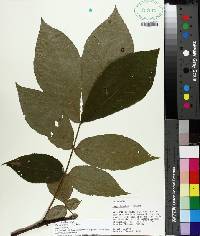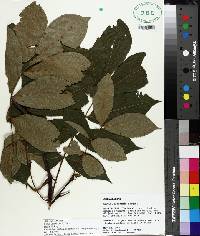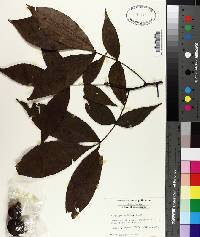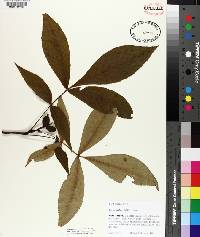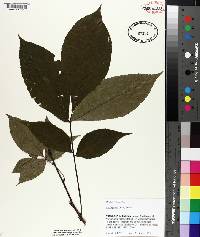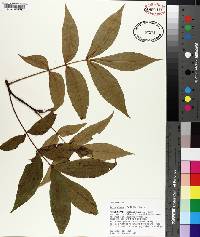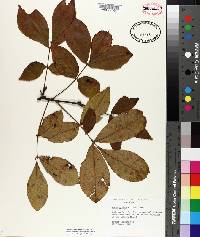Carya glabra
|
|
|
|
Family: Juglandaceae
Pignut Hickory, more...Black Hickory, sweet pignut, Small-Fruited Hickory
[Carya glabra subsp. megacarpa (Sarg.) A. E. Murray, moreCarya glabra var. hirsuta Ashe, Carya glabra var. megacarpa Sarg., Carya leiodermis Sarg., Carya leiodermis var. callicoma Sarg., Carya magnifloridana Murrill, Carya megacarpa Sarg., Carya microcarpa Nutt., Carya ovalis var. hirsuta Sarg., Carya x ovalis var. hirsuta , Hicoria austrina Small, Hicoria glabra Britton, Hicoria glabra var. hirsuta , Juglans obcordata Lam.] |
Trees , to 30 m. Bark light gray, smooth or fissured or exfoliating with small platelike scales or narrow strips. Twigs reddish brown, slender, essentially glabrous or sparsely scaly. Terminal buds reddish brown to tan, ovoid, 5-15 mm; outer scales sparsely scaly, hirsute to glabrous, inner scales finely pubescent, sparsely scaly, bud scales imbricate; axillary buds protected by bracteoles fused into hood. Leaves 2-6 dm; petiole 3-14 cm, glabrous to moderately pubescent near rachis, moderately scaly, rachis glabrous or finely puberulent. Leaflets (3-)5-7(-9), lateral petiolules 0-2 mm, terminal petiolules 2-18 mm; blades ovate to elliptic or obovate, not falcate 4-21 × 2-10 cm, margins finely to coarsely serrate, apex acuminate to narrowly acuminate; surfaces abaxially glabrous to densely pubescent with unicellular and 2-4-rayed fasciculate hairs, large peltate scales and small irregular, round, and 4-lobed peltate scales in spring, usually becoming glabrous in fall, adaxially scaly in spring. Staminate catkins pedunculate, to 13 cm, stalks glabrous or densely pubescent, bracts hirsute at tips; anthers hirsute. Fruits tan to reddish brown, obovoid, spheric or ellipsoid, not compressed to compressed, not angled, 2-4.5 × 2-3.5 cm; husks rough, 2-5 mm thick, partially dehiscent or dehiscing to base, sutures smooth or slightly winged; nuts tan, obovoid to ellipsoid, not compressed to compressed, not angled, rugulose; shells thick. Seeds sweet. Flowering spring. Edge of bayous, deep flood plains, well-drained sandy soils, rolling hills and slopes, dry rocky soils, or thin soils on edge of granite outcrops; 0-800 m; Ont.; Ala., Ark., Conn., Del., D.C., Fla., Ga., Ill., Ind., Iowa, Kans., Ky., La., Md., Mass., Mich., Miss., Mo., N.H., N.J., N.Y., N.C., Ohio, Okla., Pa., R.I., S.C., Tenn., Tex., Vt., Va., W.Va. Carya glabra is a highly polymorphic species. Tight-barked trees bearing large pear-shaped fruits are common along the Gulf Coast ( C . glabra var. megacarpa and C . leiodermis , C . magnifloridana ). Trees with exfoliating bark, reddish petioles, and small, compressed, ellipsoid fruits that dehisce to the base (i.e., C . ovalis ) are more common at higher latitudes. Carya glabra intergrades with C . floridana , C . pallida , and C . texana , and it is reported to hybridize with the diploid C . cordiformis ( C . × demareei Palmer). The extreme northern ovalis form of the species also appears to hybridize with the typical glabra in areas of sympatry.
Tree 15 - 22 m tall, trunk 30 cm - 0.75 m in diameter Leaves: alternate, odd-pinnately compound, 15 - 30 cm long, with five to seven leaflets. Flowers: either male or female, found on the same tree (monoecious), male flowers in clusters of three hanging catkins 8 - 18 cm long, female flowers in short spikes of two to five. Fruit: a nut surrounded by a husk, 2 - 4.5 cm long, 2 - 3.5 cm wide. The husk is tan to reddish brown, pear-shaped to elliptical or spherical, sometimes splitting to the base, and the nut is sometimes four-ribbed. Bark: light gray, developing thin fissures with interlacing ridges. Twigs: shiny, changing from green to reddish to gray. Terminal buds: green to gray, 0.5 - 1.5 cm long, dome-shaped, hairy, with the outer scales dropping in autumn. Leaflets: shiny yellowish green above, paler beneath, 7 - 16 cm long, 2 - 5 cm wide, the terminal leaflet largest, oblong to egg- or lance-shaped, toothed, hairy-veined beneath. Leaves turn golden in fall. Foliage is aromatic when crushed. Similar species: Carya cordiformis can be distinguished from other hickories by its sulfur-yellow buds that appear naked, nine narrow leaflets, fruit with a husk that splits to the middle, and bark that remains tight. Carya laciniosa has shaggy bark, stout orangish tan twigs with orange lenticels, seven leaflets with soft hairs beneath, very large oblong to spherical and four- to six-ridged nuts with husks splitting to the base, and large terminal buds with slightly curling outer scales. Carya ovata differs by its shaggy bark, foliage that smells like apples when crushed, five leaflets fringed with tufts of hair along the margins, nearly spherical husks that separate from a four-ridged nut, and large terminal buds with slightly curling outer scales. Carya tomentosa has fissured bark, densely hairy and reddish brown twigs, seven to nine leaflets with hairs beneath, and husks that split to the middle or base to reveal four-ridged nuts. Flowering: May to June Habitat and ecology: Occasionally found in dry upland woods. Occurence in the Chicago region: native Notes: The wood of C. glabra is used to make sporting equipment, tool handles, and furniture. Etymology: Carya comes from the Greek name for walnut. Glabra means "without hairs." Author: The Morton Arboretum Bark light or dark gray, on younger trunks tight and patterned, becoming finely furrowed and checked, later rough and deeply furrowed; outer bud-scales sparsely resinous-dotted, otherwise glabrous; petiole, rachis, and lower lf-surface soon glabrous, or pubescent only on the larger veins and in the vein-axils; lfls usually 5(7), the terminal one broadly oblanceolate to obovate; fr subglobose to obovoid, 2-3.5(-5) cm; husk 2-6 mm thick, eventually dehiscent to the middle, sometimes only along one or two sutures; nut 2-3 cm, rather thin-shelled, pale buff, slightly 4-angled or smooth, round or compressed; kernel astringent, scarcely edible, varying to bland; 2n=64. Upland woods; s. Vt. and se. N.H. to Mich., se. Io., and e. Kans., s. to Fla. and e. Tex. Gleason, Henry A. & Cronquist, Arthur J. 1991. Manual of vascular plants of northeastern United States and adjacent Canada. lxxv + 910 pp. ©The New York Botanical Garden. All rights reserved. Used by permission. From Flora of Indiana (1940) by Charles C. Deam This species [Carya glabra sensu stricto] is found principally in the southern half of the state. I think that most of the reports of it from the northern part of the state should be referred to Carya ovalis or some of its many forms. One or more trees grow on the high sand bank of the north side of Lake Ann, about 5 miles northeast of Fremont, Steuben County. E. J. Palmer has verified the determination. My record from Delaware County I am now referring to [a] Carya ovalis variety. This species and the next [Carya ovalis] are entirely distinct, but it is impossible to name correctly herbarium specimens which are incomplete, immature, or without field data. In collecting specimens of these two species, it is desirable that a note be made whether the bark of the trunk and principal branches is tight or somewhat scaly and whether the surface of the fruit is smooth or granular. The prevailing number of leaflets also should be recorded. Fruiting specimens should not be collected until mature, usually after the first of October. Flowering specimens should always be accompanied by a fruiting specimen from the same tree. [Carya glabra var. megacarpa] is distinguished from the type by its larger obovoid fruit, 2.5-4.5 cm long and by the husk, 2.5-3 mm thick. I have a specimen from Franklin County given this varietal name by Sargent. Infrequent to common on hills with black and white oak. It is especially common in the knobstone area of the state. [The following notes refer to Carya ovalis, which in the Flora of North America treatment is considered part of a variable C. glabra.][Carya ovalis, forms with prevailingly 7 rather than 5 leaflets] occurs throughout the state but infrequent to rare south of the lake area except on some of the sandy ridges of the southwestern part. In the lake area it is usually frequent to common on clay and sandy ridges with black and white oak. This [taxon] is extremely variable in the character of the bark and in the shape of its fruit and nuts. The bark is generally scaly on the principal branches and on the trunk except near the base of the tree. It is usually not thick but I know of one specimen in Lagrange County that has very thick and tight bark. The nuts of this tree are almost cubical, but otherwise the tree is typical Carya ovalis. The nuts vary from ellipsoidal to obovoid, with the base acute or rounded, the apex acute, rounded or obcordate, little or strongly compressed, the surface from nearly smooth to strongly ridged or somewhat roughened. [Carya ovalis var. obcordata, plants with oblong fruit and glabrous twigs,] is also probably found throughout the range of the species [Carya ovalis] and with it, but more rarely. [Carya ovalis var. obovalis, with obovoid nuts,] is probably found throughout the state. It is associated with the species [Carya ovalis] but less frequent. [Carya ovalis var. odorata] is separated by the resinous odor of the inner surface of the fresh husk, but I have not been able to test this character. I am referring to this variety my specimens which Sargent so named. My specimens are all from the extreme northeastern part of the state, from Allen, Grant, Lagrange, Steuben, and Wells Counties. ..... Indiana Coefficient of Conservatism: C = 4 Wetland Indicator Status: FACU Deam (1932): It seems that this tree has the ability to invade areas after the virgin forest is cut, and it is not an uncommon sight to see it in almost pure stands on the hills of cutover lands. The great abundance of this species in Brown, Morgan, and Monroe counties has been instrumental in building up a large business in the manufacture of hickory chairs and furniture. Frames of furniture are made of the very young trees, and backs and seats from the bark of old trees, which are cut, stripped of their bark, and often left to rot. |
|
|
|

